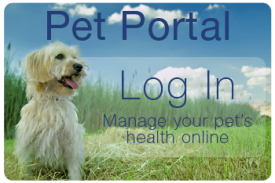Why Dental Health Is Important
One of the most common, and most preventable, diseases of dogs and cats is dental (periodontal) disease. In fact, periodontal disease is the number one health problem in cats and dogs. By 2 years of age, 70% of cats and 80% of dogs have some form of periodontal disease. However, this disease is also one of the most under-treated conditions of cats and dogs. This is partially because there are generally no outward signs of disease. Though this condition can be very painful, most animals show little or no signs of obvious pain. This is because the disease progresses gradually and most pets are so accustomed to the discomfort, they do not react as we would expect them to. Signs of periodontal disease include halitosis (bad breath), reluctance to chew on treats/toys, reluctance or difficulty eating hard food, blood-tinged saliva, drooling, pain when the mouth is touched, etc. However, many pets with periodontal disease may not display these signs. In order to determine if periodontal disease is present, a thorough oral exam should be performed by a veterinarian. In addition to severe, chronic mouth pain, periodontal disease leads to oral infections that start in the gums and move to the bone of the jaw. Infection eats away at the bone, causing bone loss which may then result in jaw fractures. Some tooth infections can even threaten other facial structures, such as the eyes and nose. These infections can also travel to the tissues of the heart, lungs, liver, and kidneys, causing organ dysfunction. There is an increased incidence of strokes, diabetes, and cancer in pets with untreated periodontal disease. Studies have found an increased risk of "generalized early mortality" associated with periodontal disease in humans, which is likely also the case with our four legged family members. In human medicine, periodontal disease is more strongly linked with early mortality than smoking! Veterinary dentists refer to periodontal disease as a "silent killer". Many pets silently suffer from this condition and, without treatment, potentially fatal consequences may result.
A common myth involving dental cleanings and periodontal treatment is that older pets or animals with existing medical conditions (e.g. heart disease, kidney disease, liver disease, etc) are not good candidates for anesthesia and dental cleanings or treatment. This is NOT TRUE! While anesthesia always involves some inherent risk, modern anesthetics and monitoring are very safe and problems are rare. Pets are never too old for proper dental care. We routinely anesthetize and perform dental work on geriatric pets. Additionally, the pets with existing heart disease, kidney disease, liver disease, diabetes, etc stand to benefit the most from having their periodontal disease treated. As discussed above, untreated periodontal disease can cause infection and dysfunction of these organ systems. In some pets, improvement is seen with their kidney disease, liver disease, diabetes, etc after their periodontal disease is treated! Many owners also report a dramatic improvement in energy level and behavior once their pet has been treated for periodontal disease.
This page offers some details about how you can keep your pet's breath fresh, as well as maintain optimum health and longevity.
To help promote dental health in our patients, our staff is ready to answer any questions you may have. We can provide advice on preventative dental care, as well as a variety of reading materials.
For a more detailed explanation of periodontal disease, see the video below, courtesy of board certified veterinary dentist Dr. Brook Niemiec:
For more information on how oral health affects the rest of the body, see board certified veterinary dentist Dr. Brett Beckman's video below.
In the followng video, Dr. Beckman also discusses how easy it is to miss signs of pain and discomfort associated with periodontal disease.
Dental Prophylaxis (Dental Cleaning)
We recommend that every pet be evaluated at least once yearly to determine if he or she is in need of a dental cleaning. Routine dental prophylaxis usually consists of scaling (removing stuck on tartar and plaque build-up) and polishing, but may also include tooth extractions, fluoride treatment, and antibiotic therapy when indicated.
The equipment we use to perform the cleaning and polishing is the same type of equipment your dentist uses. However, since a pet will not sit still and "open wide" for the procedure, the only way to do a thorough dental cleaning and exam is to use general anesthesia. We recommend that any animal over the age of eight receive at least a Complete Blood Count and Biochemical Screen (blood work) to assess the safety of anesthesia in that pet.


Before Dental Cleaning............................After Dental Cleaning
Stage 3 periodontal disease. Note the brown colored tartar, recessed gums, severe gum inflammation, and bleeding from the gum line. Infections are evident around several teeth. This condition is unhealthy and painful. After the dental cleaning, surface tartar and plaque under the gum line have been removed and the teeth polished. After assessing the health of each individual tooth, loose and diseased teeth have been extracted. Once recovered from the procedure, this patient's mouth is much healthier and pain free. Her breath is also MUCH better.
Possibly the most critical step in maintaining the clean teeth and healthy gums is home dental care. Just like with people, a combination of good dental hygiene at home and regular professional cleanings are the best way to ensure healthy teeth and gums. Tooth brushing is the best way to keep your pet's teeth and gums clean at home. However, not all pets will allow routine brushing, so we have several products and suggestions for how you can add dental home care to your pet's routine health care program.
Learn How to Brush Your Pet's Teeth
Help prevent dental disease by brushing your pet's teeth. It only takes 24 hours for plaque, which is made up of almost pure bacteria (yuck!), to establish itself on the surface of teeth after a brushing or dental cleaning. If left undisturbed, this plaque calcifies into cement-like tartar (also known as calculus) within 3 days and gum inflammation/infection (gingivitis) occurs within 2 weeks. If started early, this progression can be stopped with regular tooth brushing. Tooth brushing takes time and patience to teach your dog or cat to accept and even enjoy it, but it pays off with a more comfortable, healthier mouth and reduced professional dental cleaning costs. The best thing to do is start tooth brush training when your pet is young, before periodontal disease has had a chance to establish itself. Tooth brushing is only recommended for animals who do not currently have dental tartar or infections (tooth brushing will not reverse tooth disease once it is already established and will only cause your pet discomfort), so have your pet's mouth examined by a veterinary professional before starting tooth brushing. If your pet has established dental disease, a professional dental cleaning is recommended, followed by tooth brushing 10-14 days later (after the mouth has had a chance to heal). Just as with people, tooth brushing is ideally performed every day. If this is not possible, try to brush your pet's teeth at least 3 times a week. Step by step printed instructions are available here or you can watch the video below.
If you have any questions about dental care, or any aspect of your pet's health care, please feel free to call and speak with a staff member.


